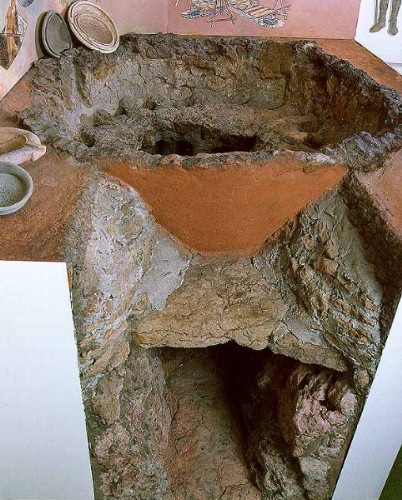|
|
Oxford Ware Pottery Kiln from Headington, Oxford: 3rd/4th century AD |

Pottery manufacture was probably Roman Britain's largest industry. Fragments of hard-fired, wheel-made, decoratively formed and finished Romano-British vessels are found everywhere in Britain, and many potters must have been required to produce them.
A major pottery industry was centred on the Roman road from Alchester to Dorchester-on-Thames, on the high ground now occupied by the eastern suburbs of Oxford. Towards the end of the 3rd century, Britain's economic position was unique in the western empire, untouched by the barbarian invasions that were damaging Gaul and Germany; business was now in local hands, the balance of trade was favourable, and the previously localised Oxford pottery industry underwent a rapid expansion. The new Headington kilns, situated near Shotover Hill, the only abundant source of white clay, concentrated on white wares, quickly capturing the regional markets for fine tableware, bowls and mortars.
The speed of expansion suggests financial investment and perhaps single ownership of the Headington industry, but production units probably remained small, and consisted of a few kilns, workshops and potters' dwellings amongst them.
The Churchill Hospital kiln, lifted bodily from site in the 1970s for display in the Museum of Oxford after replacement of the softer elements by resin, was an "updraught" kiln. A hole in the ground about a metre in diameter was lined with clay and tile, and linked to the smaller side furnace via a short channel. Layers of unbaked pots were arranged on a raised floor of tiles and fire-bars supported by a pedestal. A domed clay superstructure with ventilation holes covered all, and had to be broken after each firing.
All sites of the later 3rd and 4th centuries in Oxfordshire, Berkshire and Buckinghamshire produce primarily Oxford Ware pottery. Throughout southern England, Oxford Ware is found in fair quantity on town sites and on Romanised rural sites; and vessels of Oxford Ware were used in Scotland and in North Europe.
The three most important products of the late Roman Oxford Ware potteries were mortaria, Parchment Ware, and colour-coated ware.
The first Oxford resident whose name we know was called Tamesibugus, and was a potter.
© 1998 Oxfordshire Museum Service, Setúbal Museums and the Benaki Museum